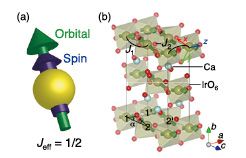Quantum Compass Model Realized in Post-Perovskite Iridate CaIrO3
Ohgushi Group
There is a new trend toward exploring Mott physics in 5d transition metal oxides with a strong spin-orbit interaction. Theoretical calculations on the Hubbard model revealed that the spin-orbit interaction drives a transition from a correlated metal to an insulator [1]. This novel Mott insulating state is actually realized in a layered perovskite Sr2IrO4, including Ir4+ ions with a (t2g)5 electronic configuration [2]. In this compound, one hole among t2g manifolds takes a complex wavefunction with the spin and orbital magnetic moments of 1/3 and 2/3 μB, respectively, and this state is now called the Jeff =1/2 state. The superexchange interaction across two Ir4+ ions in the Jeff =1/2 state is theoretically shown to be unique [3]. Whereas an antiferromagnetic Heisenberg interaction J1Si·Sj is dominant in a corner-shared IrO6 bond, the magnetic interaction of the edge-shared IrO6 bond becomes a highly anisotropic and ferromagnetic one, -J2SizSjz, where the z direction is perpendicular to the plane expanded by the two Ir atoms and two O atoms responsible for the edge-shared bond. This interaction, which is called the quantum compass model, captures great interests since a quantum spin liquid is realized when this interaction works on the honeycomb lattice (Kitaev model). To test the validity of this theory, it is necessary to elucidate the magnetic structure of an Ir oxide with an edge-sharing octahedral network.

Fig. 1. (a) The schematic view of Jeff =1/2 state. (b) Magnetic structure of the post-perovskite CaIrO3. The solid lines indicate the conventional unit cell, which is twice as large as the primitive unit cell. The magnetic interaction are also shown.
We performed resonant x-ray diffraction experiments at the L absorption edges for the post-perovskite-type compound CaIrO3, which shows a Mott insulating behavior characterized by the charge gap ~0.17 eV and undergoes a transition to a canted antiferromagnetic state at 115 K [4]. By observing the magnetic signals, we could clearly see that the magnetic structure was a striped order with an antiferromagnetic moment along the c-axis and that the wavefunction of a t2g hole is strongly spin-orbit entangled, the Jeff =1/2 state (Fig. 1). The observed spin arrangement including the weak ferromagnetic moments along the b-axis is totally consistent with the theoretical work predicting isotropic-antiferromagnetic and anisotropic-ferromagnetic superexchange interactions across the corner- and edge-sharing bonds, respectively. Our results stimulate further exploration of a novel quantum spin state in iridates.
References
- [1] D. Pesin and L. Balents, Nat. Phys. 6, 376 (2010).
- [2] B. J. Kim, H. Ohsumi, T. Komesu, S. Sakai, T. Morita, H. Takagi, and T. Arima, Science 323, 1329 (2009).
- [3] G. Jackeli and G. Khaliullin, Phys. Rev. Lett. 102, 017205 (2009).
- [4] K. Ohgushi, J. Yamaura, H. Ohsumi, K. Sugimoto, S. Takeshita, A. Tokuda, H. Takagi, M. Takata, and T. Arima, Phys. Rev. Lett. 110, 217212 (2013).
